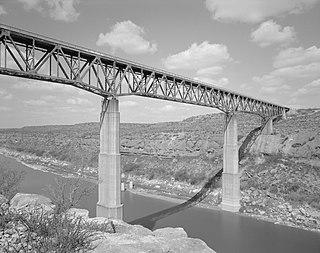Live Oak Creek, a stream with its source in Reagan County, Texas at 31°10′45″N101°42′01″W / 31.17917°N 101.70028°W at an elevation of 2938 feet, that runs southward to its mouth at an elevation of 2001 feet on the Pecos River in Crockett County, Texas. [1]

A stream is a body of water with surface water flowing within the bed and banks of a channel. The stream encompasses surface and groundwater fluxes that respond to geological, geomorphological, hydrological and biotic controls.

Reagan County is a county on the Edwards Plateau in the U.S. state of Texas. As of the 2010 census, its population was 3,367. The county seat is Big Lake. The county is named after John Henninger Reagan (1818-1905), who was the postmaster general of the Confederate States and also a U.S. Senator, U.S. Representative, and first chairman of the Railroad Commission of Texas.

The Pecos River originates in north-central New Mexico and flows into Texas, emptying into the Rio Grande. Its headwaters are on the eastern slope of the Sangre de Cristo mountain range in Mora County north of Pecos, NM, at an elevation of over 12,000 feet (3,700 m) feet. The river flows for 926 miles (1,490 km) before reaching the Rio Grande near Del Rio. Its drainage basin encompasses about 44,300 square miles (115,000 km2).
Live Oak Creek was a water source on the San Antonio-El Paso Road, 30.44 miles from Howard Springs and 3 miles from Fort Lancaster and 7.29 miles from Pecos Crossing. [2] Fort Lancaster was located to the east of this creek near its mouth.
Howard Springs, was a historical spring, located in the stream channel of Howard Draw at an elevation of 2031 feet, just north of the mouth of Government Canyon at its confluence with Howard Draw in what is now Crockett County, Texas.

Fort Lancaster, one in a series of forts erected along the western Texas frontier, is located in the Pecos River Valley, along Live Oak Creek, in Crockett County, Texas, United States. The fort was established by Captain Stephen Decatur Carpenter on August 20, 1855, to guard the military supplies, commercial shipments, and immigrants moving along the San Antonio-El Paso Road. The 82 acre site, now operated by the Texas Historical Commission as Fort Lancaster State Historic Site, contains the ruins of twenty-nine buildings that made up the fort and a visitor center with a museum about the heritage of the fort.
On July 9, 1857, Edward Fitzgerald Beale described it:

Edward Fitzgerald "Ned" Beale was a national figure in 19th century America. He was naval officer, military general, explorer, frontiersman, Indian affairs superintendent, California rancher, diplomat, and friend of Kit Carson, Buffalo Bill Cody and Ulysses S. Grant. He fought in the Mexican–American War, emerging as a hero of the Battle of San Pasqual in 1846. He achieved national fame in 1848 in carrying to the east the first gold samples from California, contributing to the gold rush.
- "Live Oak creek is a clear and beautiful stream of sweet and cool water; the grass very fine, and wood, (oak, mesquite, and willow,) abundant. Just before descending into the valley of the stream we came to a very steep, rocky hill, overlooking a valley of great beauty and graceful shape. The sides of the hills were covered with the most brilliant verdure and flowers,..." [3] :22

